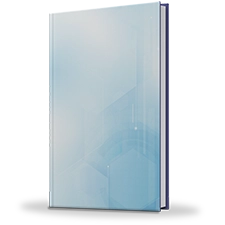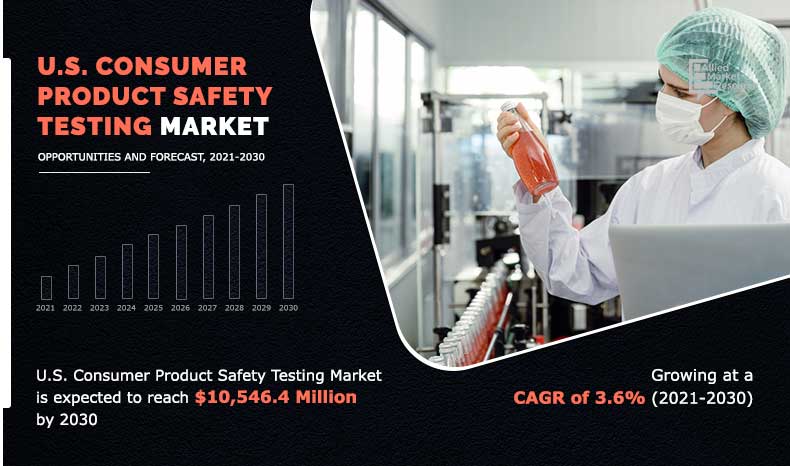U.S. Consumer Product Safety Testing Market Outlook – 2030
The U.S. consumer product safety testing market size was valued at $7,453.5 million in 2020, and is projected to reach $10,546.4 million by 2030, registering a CAGR of 3.6%.
Consumer product safety testing services include auditing, inspection, testing, verification, quality assurance, and certification of the product, equipment, and more. These help in increasing the efficiency of production to reduce errors by minimizing risk. Consumer product safety testing services are applicable in automotive, consumer electronics, healthcare, food & beverages, semiconductors, and other industries.
Increasing focus of manufacturing companies to improve customer retention by offering quality products and surging demand for interoperability testing for connected devices and IoT will drive the growth of the consumer product safety testing market. However, the high cost of such services due to diverse standards and regulations across different regions is expected to pose major threats to the market. Furthermore, digital transformation of customer services and rapid adoption of breakthrough technologies are expected to offer market opportunities to grow at a significant pace.
Increase in competition and low awareness among small-scale manufacturers a factors restricting the growth of the market. Rise in awareness of the need for product safety testing and surge in the need for safety are the factors that are opportunistic for the market growth.
According to the current U.S. consumer product safety testing market trends, the most widely used testing services are Consumer Product Safety Commission (CPSC) third-party testing and Consumer Product Safety Improvement Act (CPSIA) compliance testing. The demand for these testing services is expected to grow steadily in the forecasted period.
Segment Overview
The U.S. consumer product safety testing market is segmented based on offering, sourcing type and industry vertical.
Based on offering, the market is divided into electromagnetic compatibility, electrical safety, connectivity, electronics testing, energy efficiency testing, and others. The electronics testing segment dominated the market, in terms of revenue, in 2020, and is expected to follow the same trend during the forecast period.
By Offering
Connectivity segment will grow at a highest CAGR of 7.7% during 2021 - 2030
By sourcing type, the market is bifurcated into in-house and outsourced. The in-house segment was the highest revenue contributor in 2020 and is anticipated to garner a significant market share during the forecast period.
By Sourcing
In-House segment will maintain the lead throughout the forecast period
By industry vertical, the market is analyzed across communications, semiconductors, aerospace and defense, consumer electronics, automotive, healthcare, industrial, food and beverages, and other sectors. The food and beverages segment acquired the largest share in 2020 and is expected to grow at a high CAGR from 2021 to 2030.
By Industry Vertical
Food and Beverages segment will dominate the market during 2021 - 2030
Top Impacting Factors
Notable factors positively affecting the U.S. consumer product safety testing market outlook include increasing focus of manufacturing companies to improve customer retention by offering quality products and surging demand for interoperability testing for connected devices and IoT. However, the high cost of product safety testing services, due to diverse standards and regulations across different regions, may affect the U.S. consumer product safety testing market share. Furthermore, digital transformation of customer services and rapid adoption of breakthrough technologies are expected to offer lucrative opportunities for the U.S. consumer product safety testing market growth in the coming years.
Competitive Analysis
Competitive analysis and profiles of the major U.S. consumer product safety testing market players, such as ABS, ALS Limited, BSI Group, Bureau Veritas SA, DEKRA, DNV, Element Materials Technology, Intertek Group PLC, ISO, and TUV, are provided in this report. These key players have adopted strategies, such as product portfolio expansion, mergers & acquisitions, agreements, regional expansion, and collaboration, to enhance their market penetration.
Key Benefits for Stakeholders
- This study comprises an analytical depiction of the U.S. consumer product safety testing market size along with the current trends and future estimations to depict the imminent investment pockets.
- The overall U.S. consumer product safety testing market analysis is determined to understand the profitable trends to gain a stronger foothold.
- The report presents information related to key drivers, restraints, and opportunities with a detailed impact analysis.
- The current U.S. consumer product safety testing market forecast is quantitatively analyzed from 2021 to 2030 to benchmark the financial competency.
- Porter’s five forces analysis illustrates the potency of the buyers and suppliers in the U.S. consumer product safety testing industry.
- The report includes the market share of key vendors and U.S. consumer product safety testing market trends.
U.S. Consumer Product Safety Testing Market Report Highlights
| Aspects | Details |
| By Offering |
|
| By Sourcing Type |
|
| By Industry Vertical |
|
| By Key Market Players |
|
Analyst Review
The U.S. consumer product safety testing market is competitive, owing to strong presence of existing vendors. Consumer product safety testing companies with access to extensive technical and financial resources, are anticipated to gain a competitive edge over their rivals, as they have the capacity to cater to the market requirements. The competitive environment in this market is expected to further intensify with increase in technological innovations, product extensions, and different strategies adopted by firms.
The consumer product safety testing market holds a substantial scope for growth on a global scale. Its contribution to the market is anticipated to increase significantly during the forecast period. Recent discoveries and innovations have created vast opportunities for numerous players to step in the U.S. consumer product safety testing market. Moreover consumer product safety testing services ensure quality assurance, verification of the safety, security, and performance of a product, service, or process, higher level of cost control improvement, and faster improvement of various processes.
Increasing focus of manufacturing companies to improve customer retention by offering quality products and surging demand for interoperability testing for connected devices and IoT drives the market growth. High cost of consumer product safety testing services due to diverse standards and regulations across different geographies is the biggest limitation for the market growth.
Surge in competition and reduced awareness among small scale manufactures are the key factors that hamper the growth of the market. Increase in awareness for need of testing and rise in concern for safety and quality are the factors opportunistic for the market growth.
The key players profiled in the report include ABS, ALS Limited, BSI Group, Bureau Veritas SA, DEKRA, DNV, Element Materials Technology, Intertek Group PLC, ISO and TUV.
The U.S. consumer product safety testing market is estimated to grow at a CAGR of 3.6% from 2021 to 2030.
The U.S. consumer product safety testing market is projected to reach $10,546.4 million by 2030.
To get the latest version of sample report
Rise in awareness for need for product safety testing and surge in need of safety.
The key players profiled in the report include ABS, ALS Limited, BSI Group, Bureau Veritas SA, DEKRA, DNV, and many more.
On the basis of top growing big corporations, we select top 10 players.
The U.S. consumer product safety testing market is segmented on the basis of offering, sourcing type and industry vertical.
The key growth strategies of U.S. consumer product safety testing market players include product portfolio expansion, mergers & acquisitions, agreements, regional expansion, and collaboration.
Connectivity segment would grow at a highest CAGR of 7.7% during the forecast period.
Loading Table Of Content...




